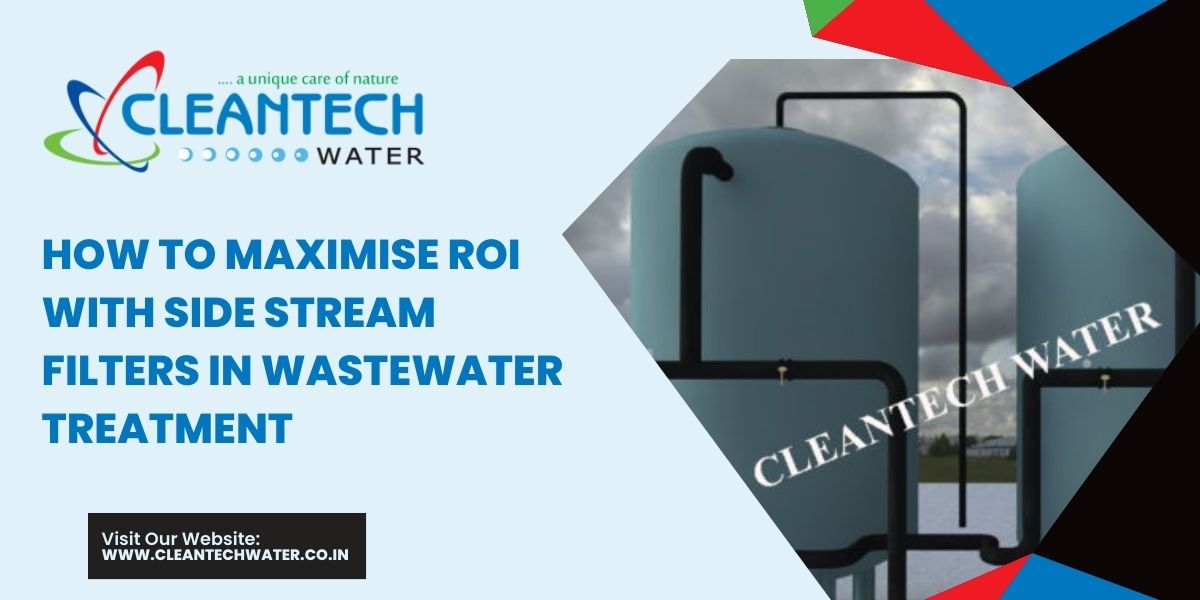Efficient wastewater treatment is essential for businesses to ensure compliance with environmental regulations and optimise operating costs. One key component in achieving this efficiency is side stream filters. These filters enhance the performance of wastewater treatment systems by removing suspended solids and other contaminants from the water. For businesses operating wastewater treatment plants, understanding how to maximise return on investment (ROI) with side stream filters can lead to significant cost savings and improved environmental outcomes.

Understanding ROI in Water Treatment
ROI is a critical metric for businesses, especially when it involves substantial investments in infrastructure like wastewater treatment systems. ROI in water treatment can be measured by evaluating the cost savings achieved through improved efficiency, reduced maintenance, and extended equipment life. Investing in a high-quality side stream filter can lead to lower operational costs, reduced downtime, and enhanced system performance, all contributing to a higher ROI.
When assessing the ROI of the filters, it’s important to consider the long-term benefits. These filters can help reduce the frequency of system cleanings and the use of chemicals, leading to lower operational costs. Moreover, they can extend the life of other equipment within the treatment system by preventing the buildup of contaminants. By understanding the comprehensive benefits of side stream filters, businesses can make informed decisions that maximise their investment.
Factors to Consider When Choosing a Side Stream Filter
Filtration Efficiency and Effectiveness
The primary function of a side stream filter is to remove suspended solids and other contaminants from the water. Therefore, filtration efficiency and effectiveness are crucial factors to consider. A filter’s ability to remove particles of varying sizes will determine its impact on water quality. High-efficiency filters can capture even the smallest particles, leading to cleaner water and more efficient overall system performance.
It’s essential to choose a side stream filter that matches the specific needs of your wastewater treatment system. Consider the types of contaminants present in your water and select a filter that can effectively remove them. Consulting with a reputable side stream filter manufacturer can provide insights into the best options for your application.
Durability and Longevity
Investing in a durable and long-lasting water filter is vital for maximising ROI. Filters that are constructed from high-quality materials and designed to withstand harsh operating conditions will require fewer replacements and less maintenance. This durability translates to cost savings over time, as businesses will not need to frequently invest in new filters or deal with the downtime associated with replacements.
When evaluating the durability of a side stream filter, consider the manufacturer’s reputation and the materials used in construction. Filters made from corrosion-resistant materials and designed for robust performance are likely to offer the best long-term value.
Maintenance Requirements and Associated Costs
Maintenance is a significant factor in the overall cost of operating a wastewater treatment system. Filters that require frequent cleaning or replacement can lead to increased labour costs and downtime. Therefore, choosing a side stream filter with minimal maintenance requirements is crucial for maximising ROI.
Look for filters that feature self-cleaning mechanisms or are designed for easy maintenance. Understanding the maintenance needs and associated costs of different filters will help you make an informed decision that aligns with your budget and operational capabilities.
Compatibility with Existing Infrastructure
Integrating a new side stream filter into your existing wastewater treatment system should be seamless. Compatibility with your current infrastructure is essential to avoid costly modifications or system disruptions. Before purchasing a filter, ensure it can be easily integrated into your existing setup.
Consulting with a side stream filter manufacturer can provide valuable guidance on selecting a filter that fits your system. They can offer custom solutions or recommend modifications to ensure a smooth integration process.
Energy Consumption and Operational Costs
Energy consumption is a critical factor in the operational costs of wastewater treatment plants. Side stream filters that operate efficiently and consume less energy can lead to significant cost savings. When evaluating filters, consider their energy requirements and how they will impact your overall energy consumption.
Filters with advanced technologies that optimise energy use can provide long-term savings. Additionally, consider the total cost of ownership, which includes not just the initial side stream filter price but also the operational costs over the filter’s lifespan. This holistic view will help you choose a filter that offers the best ROI.
Assessing Side Stream Filter Price vs. Performance
Analysing Initial Purchase Cost Versus Long-Term Savings
When selecting a side stream filter, the initial purchase cost is often a primary consideration. However, focusing solely on the upfront cost can be misleading. The long-term savings it can offer should also be a significant factor in the decision-making process. High-quality filters may have a higher initial price, but their superior performance and durability can result in substantial savings over time.
For instance, efficient side stream filters reduce the frequency of system cleanings, lower chemical usage, and prevent the accumulation of contaminants that can damage other equipment. These benefits translate to reduced maintenance costs and longer equipment lifespans, which can offset the initial investment in a higher-priced filter.
Evaluating the Total Cost of Ownership
The total cost of ownership (TCO) is a comprehensive metric that includes all costs associated with a side stream filter over its lifespan. This metric encompasses the initial purchase price, installation costs, maintenance expenses, energy consumption, and any costs related to downtime or system disruptions.
Evaluating TCO helps businesses understand the full financial impact of their investment. A filter with a low initial cost but high maintenance and operational expenses might ultimately be more expensive than a higher-priced alternative with lower ongoing costs. By analysing TCO, businesses can make more informed decisions that align with their long-term financial and operational goals.
Quantifying the Benefits of Improved Water Quality and Reduced Downtime
Improved water quality and reduced system downtime are two critical benefits of using an efficient side stream filter. High-quality filters remove more contaminants, leading to better water quality and more efficient cooling tower operation. This efficiency reduces the risk of equipment failures and extends the life of the entire system.
Quantifying these benefits involves calculating the cost savings associated with fewer repairs, less frequent replacements, and minimised downtime. For example, cleaner water reduces the wear and tear on pumps, heat exchangers, and other components, leading to longer intervals between maintenance and replacement. Reduced downtime ensures the treatment plant operates at optimal capacity, which can significantly boost overall productivity and profitability.
Strategies for Maximising ROI with Side Stream Filters
Negotiate Favourable Pricing and Terms with Suppliers
One effective strategy for maximising ROI is to negotiate favourable pricing and terms with side-stream filter manufacturers. Building strong relationships with suppliers can lead to discounts, extended warranties, and better payment terms. Additionally, some manufacturers may offer bulk purchase discounts or package deals that include maintenance services.
Conducting thorough research and obtaining quotes from multiple companies can provide leverage during negotiations. Understanding the market and being clear about your requirements can help secure the best possible deal.
Contact Us Now to Get a Free Quote!
Implement Proactive Maintenance Practices to Extend Filter Lifespan
Proactive maintenance is crucial for extending the lifespan of side stream filters and ensuring they operate efficiently. Regular inspections, timely cleaning, and prompt replacement of worn-out components can prevent minor issues from escalating into major problems. Developing a maintenance schedule based on the manufacturer’s recommendations can help maintain optimal filter performance.
Training staff on proper maintenance procedures and creating a system for tracking maintenance activities can also improve the effectiveness of these practices. Investing in high-quality maintenance tools and materials can further enhance the durability and efficiency of side stream filters.
Leverage Automation and Technology to Optimise Filter Performance
Automation and advanced technology can significantly enhance the performance of water filters. Automated systems can monitor filter conditions in real-time, adjusting operations to maintain optimal performance without manual intervention. Technologies such as IoT (Internet of Things) sensors and data analytics can provide valuable insights into filter performance, enabling predictive maintenance and reducing the risk of unexpected failures.
Implementing these technologies requires an initial investment but can lead to substantial long-term savings through improved efficiency and reduced operational costs. Automated systems also free up staff to focus on other critical tasks, enhancing overall productivity.
Monitor and Analyse Data for Ongoing Optimisation
It is important to constantly monitor and analyse data for ongoing optimisation of side stream filter performance. By collecting and analysing data on water quality, filter condition, and system performance, businesses can identify trends, detect issues early, and make informed decisions to improve efficiency.
Regularly reviewing this data allows for adjustments to be made proactively, ensuring the system operates at peak performance. Advanced data analysis tools can help pinpoint specific areas for improvement and track the effectiveness of any changes implemented.
Tips for Making Informed Decisions
Conducting Thorough Research
Making informed decisions about side stream filters begins with conducting thorough research. Start by gathering information on various manufacturers and comparing their products. Look into product specifications, filtration efficiency, and compatibility with your existing infrastructure. Read reviews and case studies to understand how different filters perform in real-world scenarios. This research will help you identify the best side stream filter that meets your specific needs and budget constraints.
Consulting with Industry Experts
Consulting with industry experts is another crucial step in the decision-making process. Experts can provide valuable insights into the latest advancements in filter technology and help you understand the nuances of different models. They can offer personalised recommendations based on your plant’s operational requirements and water quality challenges. Engaging with experts can also facilitate access to exclusive deals and warranties from reputable side-stream filter manufacturers. Their expertise ensures that you select a filter that not only optimises performance but also provides the best return on investment.
FAQs about Side Stream Filters in Wastewater Treatment
What is a side stream filter, and how does it work?
A side stream filter is a filtration system designed to remove suspended solids, debris, and other contaminants from a portion of the main water flow in a wastewater treatment plant. It works by diverting a side stream of water through the filter, which traps particles and returns cleaner water to the main system. This helps maintain water quality and protect downstream equipment from fouling and damage.
Why is a side stream filter important for cooling towers?
Side stream filters are crucial for cooling towers because they help maintain optimal water quality. By continuously filtering out suspended solids, these filters prevent the buildup of contaminants that can lead to scaling, corrosion, and biofilm formation. This results in improved cooling efficiency, reduced chemical usage, and extended equipment lifespan.
How do I determine the right size and type of side stream filter for my facility?
To determine the appropriate size and type of filter, consider factors such as the flow rate of your system, the types of contaminants present, and the specific requirements of your wastewater treatment process. It helps to consult a side stream filter manufacturer or supplier to get tailored recommendations based on your facility’s unique needs.
What are the typical maintenance requirements for side stream filters?
Maintenance requirements for side stream filters vary depending on the type and model. Generally, maintenance involves regular inspections, cleaning or replacing filter media, and checking for any wear or damage to components. Automated or self-cleaning filters may require less frequent maintenance, but it’s important to follow the manufacturer’s guidelines to ensure optimal performance.
How can I calculate the potential cost savings from using a side stream filter?
To calculate potential cost savings, consider factors such as reduced chemical and water usage, decreased maintenance and repair costs, and extended equipment lifespan. Analysing historical data on system performance and comparing it with projected improvements after installing a side stream filter can provide a clear picture of the financial benefits.
Are there any regulatory considerations when installing a side stream filter?
Yes, there may be regulatory considerations depending on your location and industry. Ensure that the side stream filter complies with local environmental regulations and standards. It’s advisable to consult with regulatory bodies or industry experts to ensure your installation meets all requirements and avoids potential legal issues.
Get Customised Solutions for Your Wastewater Treatment Plant
Cleantech Water is a leading wastewater treatment plant solution provider in India. We offer customised solutions tailored to meet your unique operational needs. By partnering with our team of experts, you’ll benefit from advanced side-stream filter technology designed to enhance efficiency, reduce costs, and ensure regulatory compliance.
Don’t settle for one-size-fits-all approaches. Let us design a system that optimises performance and maximises ROI. Whether you need upgrades, new installations, or specialised maintenance plans, we have the expertise to deliver solutions that make a difference.
Contact us at +91-9558996411 or email us at info@cleantechwater.co.in to schedule a consultation and start transforming your wastewater treatment operations. Invest in a cleaner, more efficient future for your plant with our customised solutions!

